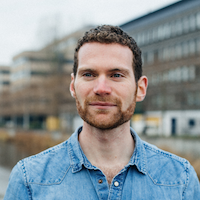A solution for training problem solving?
Pranab Mandal from University of Twente on how he trains students to develop problem solving skills using a systematic approach

by Pim Bellinga
Co-Founder of Grasple
Ranging from math exercises, to engineering problems and doing proofs, training students in solving math problems can be challenging. If you teach math or statistics, you will certainly recognize this. Problem solving skills are notoriously difficult to teach because of two reasons:
- Problem solving is supposed to be hard. It takes practice and perseverance to solve problems, so you don’t want to give away the answers too quickly, while that is often what students do ask for.
- How exactly do you help students to get better at solving problems? Is it just a lot of practice, or can you teach strategies that can make students more effective at solving problems?
 Pranab Mandal and his wife Nelly Litvak
Pranab Mandal and his wife Nelly Litvak
Over the past years, Pranab Mandal and his wife Nelly Litvak – both passionate math teachers from University of Twente (UT) – have been developing and refining a systematic approach to problem solving. It all started a few years back, when they learned about a method employed by professor Eric Mazur from Harvard University. Professor Mazur has written multiple books on effective teaching and presented his approach to helping students solve (physics) problems. Pranab and Nelly started trying out the strategy. Every session brought some new tweaks. Over the years, a structured and effective approach emerged.
One of the key aspects is that students are not graded on getting correct answers. They are only assessed on the process, i.e., how they got to their answers. Whether the answer is correct or not is irrelevant to the grade. In this article, Pranab shares their structured approach on how they train students to develop general problem solving skills.
A structured approach to develop problem solving skills
Pranab: “So here is what I do. For the problem solving session, I give out homework exercises the week before. The questions can be hard, or they can be easy. That does not really matter. Because I tell the students: “Whatever you do, you must follow four steps. They are the four steps as once described by Polya – a mathematician who has written about general strategies to solve problems.”
The four steps are:
Step 1: Getting started
Given any problem, write down what the problem asks for: this includes a) what you know and b) where you want to go. Depending on the context and the problem, this step may involve summarizing a very wordy problem, or expanding a question that has a lot of technical terms.
Step 2: Make a plan
Now that you know where you are and where you want to go, you can make a plan on how to get from the start to the finish. For example, think about which theorems you can use and make a sketch. The plan should always end with: ‘Now I (will) have proved this theorem’ or ‘now I (will) have determined the correct size’, or something like that.
Step 3: Execute the Plan
During the execution, two things can happen: you are able to completely execute your plan and you reach your goal, or the plan was too ambitious and you do not reach your goal.
Note that I call a plan with gaps too ambitious, not necessarily a wrong plan. I use positive language, because I want to show that it is not wrong to have a plan with gaps.
Step 4: Reflect
If you have reached your goal, you evaluate: is it a logical solution? Does it look reasonable? You can do that by taking a concrete (or a very extreme) case. Here you check whether your solution is probably correct.
By the way, the students always find this last step very difficult. They often omit it. But I reply that I will not accept the problem without this reflection. All four steps have to be there.
If a student did not reach the goal, then they have to reflect: why did I not reach the goal? What can I do differently? When this happens in reality, one will have to go back to step 2 and make a new plan to try to solve the problem. In my sessions, they may do that but they don’t have to. I ask them to do one full pass through the steps, including the reflection. If they have time, they may try another iteration. But I do want them to focus on the reflection, not another iteration.
Applying the steps in class
The way I use these steps in my classes consists of three phases:
Phase I. Individual phase
The first phase is where they have to go through the steps individually, using a blue or black pen. They are allowed to use the internet or books, but they are not allowed to discuss with fellow students. I also tell them why I do it like this. I say: “I know you are eager to discuss and you will have the chance to discuss the problems. But first, give it a try yourself.” I play open cards.
And the important thing to remember is: it is not about the correct answer. I do not assess the answer, I assess the procedure.
Phase II. Group phase
Then, during a class meeting, they discuss their solutions in groups. In this group phase, they mark their own work, using a red pen. The main goal here is to learn from others.
During the class they will sit in groups of four or five. I say: discuss the “getting started” step first, and see whether you understand the problem. Then move on to your plan; don’t go into details of the execution immediately.
If you see that somebody else has the same plan, but you could not execute that plan, then compare the details of the execution. Try to spot two types of mistakes: conceptual mistakes and arithmetic mistakes. I tell them: do not grade it like it is an exam. Instead, compare and see if you followed the same plan but somewhere you made a mistake.
Then halfway, I give them the actual solutions, so that they have at least one way to reach the solution. My reflection-step also often contains some observations that they did not think about. So, even if they solved the problem correctly, there will always be something marked in red. For example, in the reflection-step: ah interesting, I did not think about that.
The good thing about this is that they have thought about the problem a lot and have written about it. This way, when they come to the class for discussion, they are not new to the problem anymore. They are into it. That makes the discussion much more lively.
Phase III: Teacher Marking
First, I mark the individual part. I do not assess their execution, but I mark how they followed the process. Second, using a green pen, I mark their own correction and reflection (written in red); what I am looking for is whether they took enough insights from the discussion. So they get two marks. The final grade for the homework-set is the minimum of the two marks.
Why the minimum? On one hand, if you try to follow the four steps in the individual part, you should be able to get full points. Nothing too difficult there. But, if you just blindly followed the process and then did not take insights from the group discussion, you miss out on the learning.
On the other hand, if you did not try at all in the individual phase and then say: ‘oh, I learned so much from the given solution’, that is also not acceptable, because you did not practice the process yourself. Therefore, it is the minimum of the two. You have to try the four steps first individually, then you have to show what you have learned.
By the way, I personally find it difficult to assign a “grade” to the “learning” in the second phase. Here also, I play open cards and explain to the students that they should see the grade not as an absolute number, but that there was/is still something more to be learned from the discussion.
Apply it yourself!
A major advantage of these problem solving sessions is that we avoid students asking shallow questions, such as: “I do not know what to do or where to start.” With this method, they ask more direct questions, such as: “I looked up what ‘continuous’ means and I applied the definition but then I got stuck, because…”
Of course, as with developing any skill, the students need to practice this a lot. It would help a lot if students would be forced to employ this problem solving technique in all of their courses. Otherwise, if only applied in one course, it will be forgotten before it becomes a habit to think this way.
Do you want to try this yourself? Be open and explain to the students how you envisage that the goal of “learning” will be achieved through this method. Your students will probably not like that they have to write so much, explaining each step. By being open about the goals of the assignment and the learning process, students feel included and more responsible for their performance.
If you try it out, perhaps you will make your own tweaks and develop your own structured approach, just like Pranab and Nelly started out a few years ago.
Do you have a similar or a completely different method of helping students learn problem solving? Please share them as well. Email us at hello@grasple.com or tweet your method or experiences with teaching problem solving to @opengrasple.
As with any problem, there is probably more than one solution.
Want to stay up to date about future community news and updates? Join hundreds of statistics, math, science, and research educators and sign up for the (monthly) newsletter:
We e-mail once a month. We promise we value your inbox, so no spam.




